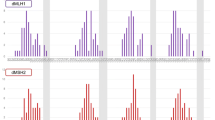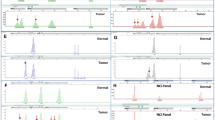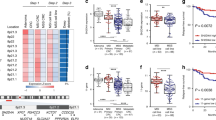Abstract
About half of hereditary non-polyposis colorectal cancers (HNPCCs) fulfilling the Amsterdam criteria (AC) do not display evidence of mismatch repair defects, and the difference between microsatellite-stable (MSS) and microsatellite-unstable HNPCC remains poorly understood. The study was to compare overall copy number variation (CNV) and loss of heterozygosity (LOH) of the entire genome in HNPCCs with MSS and microsatellite-instability (MSI) using the Cytoscan HD Array. This was a study carried out in samples from 20 patients with MSS HNPCC and four patients with MSI HNPCC from the Fudan University Shanghai Cancer Center (China). The microsatellite status was examined using a panel of microsatellite markers. MMR expression status was evaluated by immunohistochemistry. Tumor samples were analyzed with the Genome-Wide Human CytoScan HD Array. CNV and LOH were determined. Fourteen specific CNVs (eight gains: 5p13.1, 7p13, 7q22.3, 8q11.21, 8q12.2, 19q13.11, 20q11.21, and 20q11.23; and six losses: 8p22, 8p23.1, 8p23.1, 17p13.1, 17p13.2, and 18q21.3) were associated with MSS HNPCC. Of these 14 CNVs, gain on 8q12.2 and loss on 17p13.1 were novel. The total length of 8q gains and 20q gains were greater in MSS tumors than in MSI (P < 0.05). The presence of similar levels of copy-neutral-LOH in MSS (31.7%) and MSI (29.7%) HNPCC suggested that unknown DNA repair genes might be involved in the tumorigenesis of MSS HNPCC. MSS HNPCC is a genetically specific population with increased CNV, which are different from MSI HNPCC. The results may help to clarify the genetic basis of MSS HNPCC tumorigenesis.


Similar content being viewed by others
References
Abdel-Rahman WM, Ollikainen M, Kariola R, Jarvinen HJ, Mecklin JP, Nystrom-Lahti M, Knuutila S, Peltomaki P (2005) Comprehensive characterization of HNPCC-related colorectal cancers reveals striking molecular features in families with no germline mismatch repair gene mutations. Oncogene 24:1542–1551. doi:10.1038/sj.onc.1208387
Boland CR, Thibodeau SN, Hamilton SR, Sidransky D, Eshleman JR, Burt RW, Meltzer SJ, Rodriguez-Bigas MA, Fodde R, Ranzani GN, Srivastava S (1998) A National Cancer Institute Workshop on Microsatellite Instability for cancer detection and familial predisposition: development of international criteria for the determination of microsatellite instability in colorectal cancer. Cancer Res 58:5248–5257
Byers SW, Rowlands T, Beildeck M, Bong YS (2012) Mechanism of action of vitamin D and the vitamin D receptor in colorectal cancer prevention and treatment. Rev Endocr Metab Disord 13:31–38. doi:10.1007/s11154-011-9196-y
Cahan P, Li Y, Izumi M, Graubert TA (2009) The impact of copy number variation on local gene expression in mouse hematopoietic stem and progenitor cells. Nat Genet 41:430–437. doi:10.1038/ng.350
Carvalho B, Postma C, Mongera S, Hopmans E, Diskin S, van de Wiel MA, van Criekinge W, Thas O, Matthai A, Cuesta MA, Terhaar Sive Droste JS, Craanen M, Schrock E, Ylstra B, Meijer GA (2009) Multiple putative oncogenes at the chromosome 20q amplicon contribute to colorectal adenoma to carcinoma progression. Gut 58:79–89. doi:10.1136/gut.2007.143065
Chen W, Yuan L, Cai Y, Chen X, Chi Y, Wei P, Zhou X, Shi D (2013) Identification of chromosomal copy number variations and novel candidate loci in hereditary nonpolyposis colorectal cancer with mismatch repair proficiency. Genomics 102:27–34. doi:10.1016/j.ygeno.2013.02.003
Chung DC, Rustgi AK (2003) The hereditary nonpolyposis colorectal cancer syndrome: genetics and clinical implications. Ann Intern Med 138:560–570
Gilbert R, Martin RM, Beynon R, Harris R, Savovic J, Zuccolo L, Bekkering GE, Fraser WD, Sterne JA, Metcalfe C (2011) Associations of circulating and dietary vitamin D with prostate cancer risk: a systematic review and dose-response meta-analysis. Cancer Causes Control 22:319–340. doi:10.1007/s10552-010-9706-3
Hainaut P, Hollstein M (2000) p53 and human cancer: the first ten thousand mutations. Adv Cancer Res 77:81–137
Iafrate AJ, Feuk L, Rivera MN, Listewnik ML, Donahoe PK, Qi Y, Scherer SW, Lee C (2004) Detection of large-scale variation in the human genome. Nat Genet 36:949–951. doi:10.1038/ng1416
Job B, Bernheim A, Beau-Faller M, Camilleri-Broet S, Girard P, Hofman P, Mazieres J, Toujani S, Lacroix L, Laffaire J, Dessen P, Fouret P, Investigators LG (2010) Genomic aberrations in lung adenocarcinoma in never smokers. PLoS One 5:e15145. doi:10.1371/journal.pone.0015145
Kita Y, Nishiyama M, Nakayama KI (2012) Identification of CHD7S as a novel splicing variant of CHD7 with functions similar and antagonistic to those of the full-length CHD7L. Genes Cells 17:536–547. doi:10.1111/j.1365-2443.2012.01606.x
Kuo KT, Guan B, Feng Y, Mao TL, Chen X, Jinawath N, Wang Y, Kurman RJ, Shih Ie M, Wang TL (2009) Analysis of DNA copy number alterations in ovarian serous tumors identifies new molecular genetic changes in low-grade and high-grade carcinomas. Cancer Res 69:4036–4042. doi:10.1158/0008-5472.CAN-08-3913
Lips EH, de Graaf EJ, Tollenaar RA, van Eijk R, Oosting J, Szuhai K, Karsten T, Nanya Y, Ogawa S, van de Velde CJ, Eilers PH, van Wezel T, Morreau H (2007) Single nucleotide polymorphism array analysis of chromosomal instability patterns discriminates rectal adenomas from carcinomas. J Pathol 212:269–277. doi:10.1002/path.2180
Lips EH, van Eijk R, de Graaf EJ, Doornebosch PG, de Miranda NF, Oosting J, Karsten T, Eilers PH, Tollenaar RA, van Wezel T, Morreau H (2008) Progression and tumor heterogeneity analysis in early rectal cancer. Clin Cancer Res 14:772–781. doi:10.1158/1078-0432.CCR-07-2052
Liu GE, Bickhart DM (2012) Copy number variation in the cattle genome. Funct Integr Genomics 12:609–624. doi:10.1007/s10142-012-0289-9
Llor X, Pons E, Xicola RM, Castells A, Alenda C, Pinol V, Andreu M, Castellvi-Bel S, Paya A, Jover R, Bessa X, Giros A, Roca A, Gassull MA, Gastrointestinal Oncology Group of the Spanish Gastroenterological A (2005) Differential features of colorectal cancers fulfilling Amsterdam criteria without involvement of the mutator pathway. Clin Cancer Res 11:7304–7310. doi:10.1158/1078-0432.CCR-05-0965
Lynch HT, de la Chapelle A (1999) Genetic susceptibility to non-polyposis colorectal cancer. J Med Genet 36:801–818
Manolio TA, Collins FS, Cox NJ, Goldstein DB, Hindorff LA, Hunter DJ, McCarthy MI, Ramos EM, Cardon LR, Chakravarti A, Cho JH, Guttmacher AE, Kong A, Kruglyak L, Mardis E, Rotimi CN, Slatkin M, Valle D, Whittemore AS, Boehnke M, Clark AG, Eichler EE, Gibson G, Haines JL, Mackay TF, McCarroll SA, Visscher PM (2009) Finding the missing heritability of complex diseases. Nature 461:747–753. doi:10.1038/nature08494
Masson AL, Talseth-Palmer BA, Evans TJ, Grice DM, Duesing K, Hannan GN, Scott RJ (2013) Copy number variation in hereditary non-polyposis colorectal cancer. Genes (Basel) 4:536–555. doi:10.3390/genes4040536
Middeldorp A, van Puijenbroek M, Nielsen M, Corver WE, Jordanova ES, ter Haar N, Tops CM, Vasen HF, Lips EH, van Eijk R, Hes FJ, Oosting J, Wijnen J, van Wezel T, Morreau H (2008) High frequency of copy-neutral LOH in MUTYH-associated polyposis carcinomas. J Pathol 216:25–31. doi:10.1002/path.2375
Middeldorp A, Jagmohan-Changur SC, van der Klift HM, van Puijenbroek M, Houwing-Duistermaat JJ, Webb E, Houlston R, Tops C, Vasen HF, Devilee P, Morreau H, van Wezel T, Wijnen J (2010) Comprehensive genetic analysis of seven large families with mismatch repair proficient colorectal cancer. Genes Chromosomes Cancer 49:539–548. doi:10.1002/gcc.20763
Middeldorp A, van Eijk R, Oosting J, Forte GI, van Puijenbroek M, van Nieuwenhuizen M, Corver WE, Ruano D, Caldes T, Wijnen J, Morreau H, van Wezel T (2012) Increased frequency of 20q gain and copy-neutral loss of heterozygosity in mismatch repair proficient familial colorectal carcinomas. Int J Cancer 130:837–846. doi:10.1002/ijc.26093
Nakao M, Kawauchi S, Uchiyama T, Adachi J, Ito H, Chochi Y, Furuya T, Oga A, Sasaki K (2011) DNA copy number aberrations associated with the clinicopathological features of colorectal cancers: Identification of genomic biomarkers by array-based comparative genomic hybridization. Oncol Rep 25:1603–1611. doi:10.3892/or.2011.1246
Ohrling K, Edler D, Hallstrom M, Ragnhammar P (2010) Mismatch repair protein expression is an independent prognostic factor in sporadic colorectal cancer. Acta Oncol 49:797–804. doi:10.3109/02841861003705786
Sakuma Y, Yamazaki Y, Nakamura Y, Yoshihara M, Matsukuma S, Koizume S, Miyagi Y (2012) NF-kappaB signaling is activated and confers resistance to apoptosis in three-dimensionally cultured EGFR-mutant lung adenocarcinoma cells. Biochem Biophys Res Commun 423:667–671. doi:10.1016/j.bbrc.2012.06.009
Sanchez-de-Abajo A, de la Hoya M, van Puijenbroek M, Tosar A, Lopez-Asenjo JA, Diaz-Rubio E, Morreau H, Caldes T (2007) Molecular analysis of colorectal cancer tumors from patients with mismatch repair proficient hereditary nonpolyposis colorectal cancer suggests novel carcinogenic pathways. Clin Cancer Res 13:5729–5735. doi:10.1158/1078-0432.CCR-06-2996
Schnabl B, Valletta D, Kirovski G, Hellerbrand C (2011) Zinc finger protein 267 is up-regulated in hepatocellular carcinoma and promotes tumor cell proliferation and migration. Exp Mol Pathol 91:695–701. doi:10.1016/j.yexmp.2011.07.006
Sekal M, Ameurtesse H, Chbani L, Ouldim K, Bennis S, Abkari M, Boulouz A, Benajah DA, Benjelloun B, Ousadden A, Ait Taleb K, Ait Laalim S, Toghrai I, Mazaz K, Arifi S, Mellas N, El Rhazi K, Harmouch T, Ibrahimi SA, Amarti Riffi A (2015) Epigenetics could explain some Moroccan population colorectal cancers peculiarities: microsatellite instability pathway exploration. Diagn Pathol 10:77. doi:10.1186/s13000-015-0326-9
Sillars-Hardebol AH, Carvalho B, Belien JA, de Wit M, Delis-van Diemen PM, Tijssen M, van de Wiel MA, Ponten F, Fijneman RJ, Meijer GA (2012) BCL2L1 has a functional role in colorectal cancer and its protein expression is associated with chromosome 20q gain. J Pathol 226:442–450. doi:10.1002/path.2983
Silva FP, Hamamoto R, Nakamura Y, Furukawa Y (2005) WDRPUH, a novel WD-repeat-containing protein, is highly expressed in human hepatocellular carcinoma and involved in cell proliferation. Neoplasia 7:348–355
Takita J, Chen Y, Okubo J, Sanada M, Adachi M, Ohki K, Nishimura R, Hanada R, Igarashi T, Hayashi Y, Ogawa S (2011) Aberrations of NEGR1 on 1p31 and MYEOV on 11q13 in neuroblastoma. Cancer Sci 102:1645–1650. doi:10.1111/j.1349-7006.2011.01995.x
Thompson PA, Brewster AM, Kim-Anh D, Baladandayuthapani V, Broom BM, Edgerton ME, Hahn KM, Murray JL, Sahin A, Tsavachidis S, Wang Y, Zhang L, Hortobagyi GN, Mills GB, Bondy ML (2011) Selective genomic copy number imbalances and probability of recurrence in early-stage breast cancer. PLoS One 6:e23543. doi:10.1371/journal.pone.0023543
Uddin M, Thiruvahindrapuram B, Walker S, Wang Z, Hu P, Lamoureux S, Wei J, MacDonald JR, Pellecchia G, Lu C, Lionel AC, Gazzellone MJ, McLaughlin JR, Brown C, Andrulis IL, Knight JA, Herbrick JA, Wintle RF, Ray P, Stavropoulos DJ, Marshall CR, Scherer SW (2015) A high-resolution copy-number variation resource for clinical and population genetics. Genet Med 17:747–752. doi:10.1038/gim.2014.178
Umemura N, Zhu J, Mburu YK, Forero A, Hsieh PN, Muthuswamy R, Kalinski P, Ferris RL, Sarkar SN (2012) Defective NF-kappaB signaling in metastatic head and neck cancer cells leads to enhanced apoptosis by double-stranded RNA. Cancer Res 72:45–55. doi:10.1158/0008-5472.CAN-11-1484
van Puijenbroek M, Middeldorp A, Tops CM, van Eijk R, van der Klift HM, Vasen HF, Wijnen JT, Hes FJ, Oosting J, van Wezel T, Morreau H (2008) Genome-wide copy neutral LOH is infrequent in familial and sporadic microsatellite unstable carcinomas. Fam Cancer 7:319–330. doi:10.1007/s10689-008-9194-8
Veerappa AM, Padakannaya P, Ramachandra NB (2013) Copy number variation-based polymorphism in a new pseudoautosomal region 3 (PAR3) of a human X-chromosome-transposed region (XTR) in the Y chromosome. Funct Integr Genomics 13:285–293. doi:10.1007/s10142-013-0323-6
Wang CF, Zhou XY, Zhang TM, Sun MH, Shi DR (2005) Detection of germline mutations of hMLH1 and hMSH2 based on cDNA sequencing in China. World J Gastroenterol 11:6620–6623
Xiao XY, Zhou XY, Yan G, Sun MH, Du X (2007) Chromosomal alteration in Chinese sporadic colorectal carcinomas detected by comparative genomic hybridization. Diagn Mol Pathol 16:96–103. doi:10.1097/PDM.0b013e31803190f2
Yao B, Fu J, Hu E, Qi Y, Zhou Z (2007) The Cdc25A is involved in S-phase checkpoint induced by benzo(a)pyrene. Toxicology 237:210–217. doi:10.1016/j.tox.2007.05.015
Yoshihara K, Tajima A, Adachi S, Quan J, Sekine M, Kase H, Yahata T, Inoue I, Tanaka K (2011) Germline copy number variations in BRCA1-associated ovarian cancer patients. Genes Chromosomes Cancer 50:167–177. doi:10.1002/gcc.20841
Zafarana G, Ishkanian AS, Malloff CA, Locke JA, Sykes J, Thoms J, Lam WL, Squire JA, Yoshimoto M, Ramnarine VR, Meng A, Ahmed O, Jurisica I, Milosevic M, Pintilie M, van der Kwast T, Bristow RG (2012) Copy number alterations of c-MYC and PTEN are prognostic factors for relapse after prostate cancer radiotherapy. Cancer 118:4053–4062. doi:10.1002/cncr.26729
Zahir FR, Marra MA (2015) Use of Affymetrix Arrays in the Diagnosis of Gene Copy-Number Variation. Curr Protoc Hum Genet 85:8 13 11–13. doi:10.1002/0471142905.hg0813s85
Zhu ZZ, Wang D, Cong WM, Jiang H, Yu Y, Wen BJ, Dong H, Zhang X, Liu SF, Wang AZ, Zhu G, Hou L (2012) Sex-related differences in DNA copy number alterations in hepatitis B virus-associated hepatocellular carcinoma. Asian Pac J Cancer Prev 13:225–229
Zimonjic DB, Popescu NC (2012) Role of DLC1 tumor suppressor gene and MYC oncogene in pathogenesis of human hepatocellular carcinoma: potential prospects for combined targeted therapeutics (review). Int J Oncol 41:393–406. doi:10.3892/ijo.2012.1474
Acknowledgments
The authors acknowledge the help of the staff at the Department of Pathology of the Fudan University Shanghai Cancer Center.
Author information
Authors and Affiliations
Corresponding author
Ethics declarations
Funding
This work was supported by the National Natural Science Foundation of China (no. 81302163), Shanghai Pudong New Area science and technology development fund, innovation fund (no. PKJ2013-Y08), and Excellent Academic Leaders of Shanghai Pudong New Area (No.PWRd2013-01).
Conflict of interest
The authors declare that they have no conflict of interest.
Human and animal ethical rights
All procedures performed in studies involving human participants were in accordance with the ethical standards of the Fudan University Shanghai Cancer Center research committee and with the 1964 Helsinki declaration and its later amendments or comparable ethical standards.
Informed consent
Informed consent was obtained from all individual participants included in the study.
Additional information
Weixiang Chen and Jun Ding contributed equally to this work.
Rights and permissions
About this article
Cite this article
Chen, W., Ding, J., Jiang, L. et al. DNA copy number profiling in microsatellite-stable and microsatellite-unstable hereditary non-polyposis colorectal cancers by targeted CNV array. Funct Integr Genomics 17, 85–96 (2017). https://doi.org/10.1007/s10142-016-0532-x
Received:
Revised:
Accepted:
Published:
Issue Date:
DOI: https://doi.org/10.1007/s10142-016-0532-x




